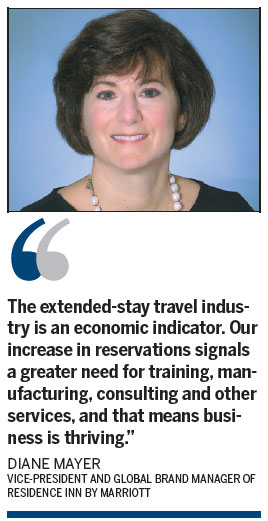Seeing double
Updated: 2014-07-12 06:54
By Pauline D.Loh (China Daily)
|
|||||||||||
Residence Inn "operates with more knowledge of the extended-stay traveler ... and delivering on our guests' needs for more living space, beautiful and functional physical environments, and an energetic and passionate service staff is how we maintain our leadership position in the market."
This segment of the market is growing. At the moment, long-stay hospitality brands account for 1 percent of the Marriott group's business, but it goes up to 8 percent in the pipeline.
"The extended-stay travel industry is an economic indicator. Our increase in reservations signals a greater need for training, manufacturing, consulting and other services, and that means business is thriving," Mayer had said in a previous statement.
It still holds true, especially in China, where all major international hospitality groups are gazing longingly for its market potential. It is harder and harder to profit as competition gets heated and crowded and, already, room rates in the top hotels are being forced down.
As the country gets down to real business and the novelty of reckless spending slowly calms, it is brands like Residence Inn and Courtyard that will fill the vacuum.
Let's look at how double-branding works, according to the Marriott model.
The Residence Inn is an all-suite hotel, with a kitchenette attached to the bedroom, a little living and study area designed to cater to the long-stay business traveler averaging about two weeks or more. Amenities are basic, no-fuss and the location is usually central.
Its twin brand, the Courtyard, caters to travelers who want an extended stay, but for a relatively shorter period. Both brands often share the same lobby, the gym and the swimming pool, and a restaurant where breakfast is served daily.
In Los Angeles, the Marriott group also does a high-end brand pairing. Just across the road from the Residence Inn/Courtyard is the Ritz-Carlton and JW, where celebrity chef Wolfgang Puck parks his WP 24 restaurant.
Both brands retain their signature decor styles, but the shared facilities make great economic sense in times when sustainable use of resources is a tipping point for socially conscious guests.
On the swimming pool level of the Ritz-Carlton, for instance, you can enjoy a view of LA by day and night, a good swim in an attractive pool and wander through an herb garden where the Ritz-Carlton and JW chefs harvest lemons, limes, rosemary, basil, oregano and pomegranates among other seasonal plantings. The artichokes are a decorative feature.
Mayer says they are already looking at Chengdu, where the group already has a Ritz-Carlton. Business travelers may soon be booking into a Residence Inn/Courtyard.
Related Stories
Zen-themed hotel opens at China's Buddhist sacred site 2014-03-24 14:51
Dame Judi Dench won't attend Oscars 2014-03-03 10:31
Art checks into the Four Seasons for the fall 2013-11-03 11:12
Lv garden 2013-09-26 16:14
Dating ideas for Qixi 2013-08-12 15:49
Today's Top News
Int'l investigation team on MH17 formed
Meat supplier of McDonald's, KFC suspended in Shanghai
Gaza death toll pass 100
Lunar rover is 'awake'
Burning wreckage, bodies scattered after jet downed
Xi makes plea for 'cyperpeace'
China's GDP growth 'in range'
Israeli forces roll into Gaza
Hot Topics
Lunar probe , China growth forecasts, Emission rules get tougher, China seen through 'colored lens', International board,
Editor's Picks

|

|

|

|

|

|






